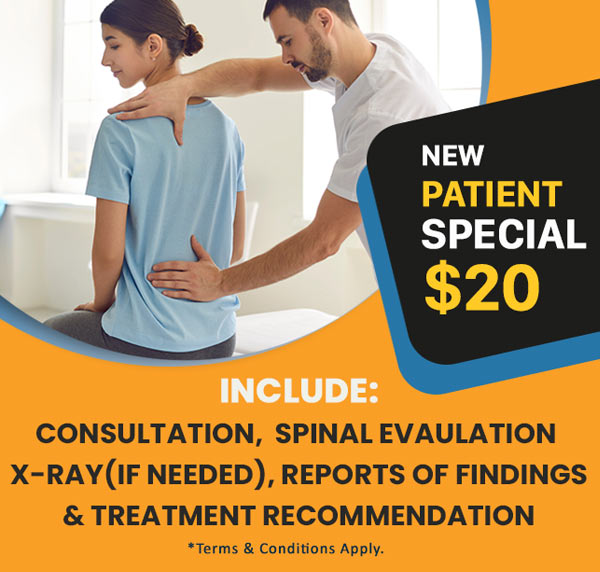Hip Pain: Common Causes and How Chiropractic Can Help

Our hips serve innumerable functions for our body; they keep us upright, allow us to bear weight, walk smoothly, run, jump, kick, play. Since the hips are engaged in nearly every way we move, pain in this area can have debilitating consequences for patients. Although hip pain is frequently the result of osteoarthritis or injury, it can also be a sign of other health conditions. A doctor of chiropractic can help you identify the source of your hip pain and develop a tailored treatment plan for your symptoms.
Common Causes of Hip Pain
Inflammation
Hip pain can derive from the structures within the hip joint or from the structures and ligaments surrounding the joint. Within the joint itself, there is limited space for the femoral head to move in the socket of the acetabulum. If an injury or illness triggers inflammation, this space can become easily filled with fluid or blood, causing pain. Inflammation of the sac outside of the hip, the bursitis, can also be the source of pain. Bursitis is often the result of minor trauma or overuse.
Osteoarthritis and Inflammatory Diseases
Among older adults, osteoarthritis is the most common cause of hip pain. It involves a cycle of progressive cartilage loss and joint degeneration. Although this degenerative disease has no real “cure”, there are ways to slow its progression and prevent symptoms from worsening. Other inflammatory diseases can also cause hip pain like rheumatoid arthritis, inflammatory bowel disease, or inflammation of the spine (ankylosing spondylitis).
Overuse Injuries
Heavy wear and tear on the cartilage surrounding the hip joint can cause arthritis and inflammation. Routine daily activities that place stress on the hip can also cause inflammation of the muscles, tendons, and ligaments surrounding the hip. This type of pain can develop gradually overtime.
Trauma
Less subtle than overuse injuries, fractures and dislocations of the hip or pelvis are easier to diagnose since they frequently result from direct trauma and can be detected with an X-ray. In elderly patients, a combination of aging, brittle bones, and poor balance makes them susceptible to falls and hip fractures.
Even if no bones actually break, the ligaments and muscles in the hip area can be strained, sprained, or bruised with direct trauma. These injuries can still cause significant pain.
Referred Pain and Other Sources of Hip Pain
Often what patients describe as “hip pain” may actually derive from a different part of the body. Some patients that experience pain in the lower back and hips may actually be suffering from dysfunction of the sacroiliac joints, or the joints that connect the sacrum to the iliac bones. Pain in the groin and hip can also be a result of a hernia, when the abdominal wall is torn or weakened.
One of the more common types of referred pain is sciatica, or inflammation or irritation of the sciatic nerve. This can result from conditions like disc herniation, spinal degeneration, narrowing of the spine due to osteoarthritis, or Piriformis syndrome. Irritation of the nerve root can cause pain the in low-back, buttocks, hips, as well as radiating leg pain.
How Chiropractic Can Help Hip Pain
After performing a careful physical examination and evaluating your familial and personal history, a doctor of chiropractic can work to determine the source of your hip pain. Your chiropractor will create a personalized treatment plan that could include chiropractic adjustments, exercise therapy, posture advice, stretching, massage, coordination with other health practitioners, and more. Treatments will aim to reduce inflammation, relax any existing muscle spasms, strengthen weakened muscles, and improve the mobility of the joint.
Depending on the cause of your hip pain, chiropractic adjustments could help.
Multiple studies have found that chiropractic adjustments are effective in relieving sciatica, a common cause of pain in the hip and lower back. In a study comparing the efficacy of chiropractic to surgery for sciatica, 60% of chiropractic patients with severe sciatica had substantially improved symptoms that enabled them to avoid surgery.2 Cases studies have also suggested that chiropractic can relieve pain associated with sacroiliac joint dysfunction and Piriformis syndrome, which both frequently result in hip pain.3-4
Some patients with hip osteoarthritis (HOA) have also benefited from chiropractic care. In one study, 83% of HOA patients improved within nine visits to a chiropractor. Treatment included axial manipulation of the hip, stretching, and full kinetic chain treatment ( manipulative therapy to the spine, knee, ankle, or foot when appropriate).5
Natural treatments of hip pain can allow patients to avoid the costs and risks of surgery and drugs. Contact a chiropractor to learn more about non-invasive relief of hip pain.
References
1. Wedro, Benjamin. “Hip Pain: Causes, Symptoms, Treatment Information and Diagnosis-eMedicineHealth.” http://www.emedicinehealth.com/hip_pain/article_em.htm.
2. McMorland G, Suter E, Casha S, du Plessis SJ, Hurlbert RJ. Manipulation or microdiskectomy for sciatica? A prospective randomized clinical study. Journal of Manipulative and Physiological Therapeutics. 2010; 33(8): 576-584.
3. Chapman C, Bakkum BW. Chiropractic management of a US Army veteran with low back pain and piriformis syndrome complicated by an anatomical anomaly of the piriformis muscle: a case study. Journal of Chiropractic Medicine 2012; 11(1): 24-9.
4. Kamali, Fahimeh and Esmaeil Shokri. The effect of two manipulative therapy techniques and their outcome in patients with sacroiliac joint syndrome. Journal of Bodywork and Movement Therapies. 2012; 16: 29-35.
5. Brantingham JW, Globe GA, Cassa TK, et al. A single-group pretest posttest design using full kinetic chain manipulative therapy with rehabilitation in the treatment of 18 patients with hip osteoarthritis. Journal of Manipulative and Physiological Therapy 2012; 33(6): 445-57.
